MKTNG 10th Anniversary Special: The Creative Evolution – An Interview with Josh McCowen
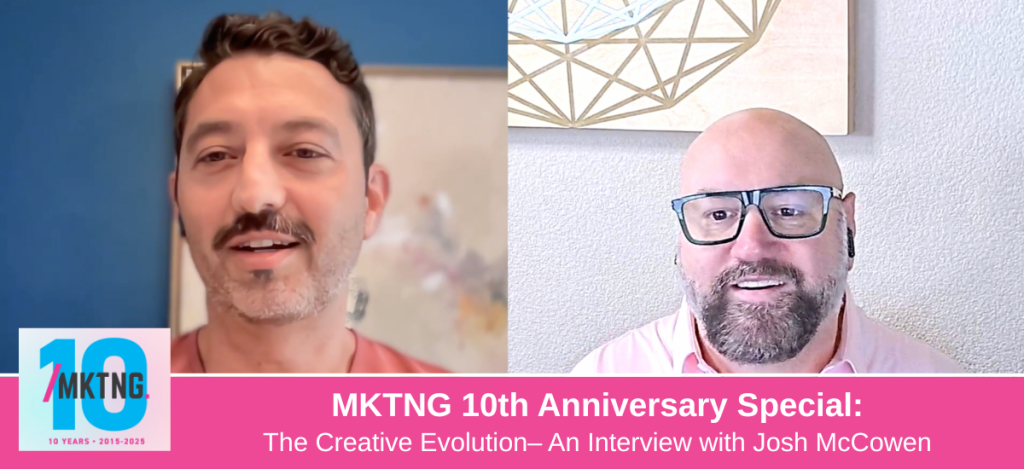
Host Scott Eggert and Creative Director Josh McCowen discuss the evolving creative landscape over the last decade, noting the massive shift from print design to digital platforms like social media and websites. While embracing the speed of modern tools like Figma and Photoshop, Josh stresses the continued importance of fundamental creative strategy and manual processes, such as sketching on paper, to generate recall and meaningful ideas. The conversation zeroes in on the opportunities and challenges posed by the modern social environment, using the Cracker Barrel rebrand as an example of how public opinion can impact even established brands. They dive deep into the pervasive influence of AI (like Midjourney), which Josh uses as a technical and coding partner, but caution that current AI tends to produce “remarkably average” content and lacks the essential strategic perspective needed for truly great branding. Finally, Josh shares his work on his new venture, A Remembered Life, and wraps up the discussion with a quick “Keep or Kill” lightning round, where he keeps most design concepts but kills Papyrus and direct mail. Key Topics: The Evolution of Design and Marketing The Importance of Manual Creative Process The Impact of Social Media on Branding Defining a Brand AI’s Role in Creative Workflow Limitations and Caveats of AI The Future of Technology in Business Entrepreneurship and New Ventures “Keep or Kill” Design Concepts Personal Creative Pursuits Transcript: Scott: All right. So what does it take to build a brand that lasts? We’re exploring that very question today on the MK ten podcast. I’m the host, Scott Agar, president of MK tag. And I couldn’t think of a better person to discuss this with. And uh, our, my friend and our creative director, Josh McCown, uh, who’s been, uh, fostering, uh, innovation and working with collaborative, uh, teams from doing global brand launches and innovative digital experiences, his work has consistently pushed the boundaries. I can’t wait to dive into the story of creative evolution with him. Josh, it’s great to have you here. Welcome to Mk2 G10. This is a series you put together just to celebrate our ten years, and Josh is a cool part of that story. Cool. Glad to be here. Yeah. Yeah. So, uh, since we’re, you know, ten years, uh, for our outfit here, we, like, we’ve been kind of talking to, uh, you know, everybody on our team, uh, and some previous team members, kind of about what has changed in your tenure, uh, as a designer, what’s something that, uh, you know, you used to do that would just seem archaic, uh, if you were to, you know, pick up that tool or technology and use it today. Josh: I mean, I think the biggest thing for me is, as broadly as it sounds, print, um, which I desperately miss. Um, certainly there’s large brands that still do a lot of print work and, you know, you still see print, but, you know, working with modern tech startups today, a lot of companies, they’re all digital. It’s social media, it’s a website, it’s email. And that’s as far as they take their brand and marketing touchpoints. Obviously brick and mortar shops, things like that, restaurants, you know, anything where there’s a human in person, there’s still going to be some type of collateral. But yeah, I, I wish, I wish more brands to still did print design. Um, that was my initial, uh, endeavor into the design world was illustration and building brochures and annual reports and things like that. Um, but today we we pretty much just do websites and social media and applications and, you know, much more of a digital world these days. Scott: Yeah. Like is there. Are there any tools or a process that you do now that’s just like 180 degrees from how you used to do things? Josh: Um, I’m sure there is. I’m trying to think if there is something that we did like so manually that I got replaced. I mean, obviously we’ll touch on it as the conversation goes on, but AI is changing some of our kind of baseline processes. But I think from a kind of fundamental creative process understanding, uh, discovery process, a lot of the things that we do, or at least I do, I try to kind of maintain some of those best practices from, from before because they weren’t, you know, the tools can help us move faster, but they’re not going to answer our questions. They’re not going to know our insight. They’re not going to be able to pull out some of the things that, you know, you and I and some other, uh, industry people that have been in the around as long as we have the knowledge that we have. So, you know, I maybe don’t sketch as much as I used to on paper, um, when I’m working on maybe collateral or logos and things like that. But, you know, we still use Photoshop. Maybe not as much as we used to in the past. Um, but yeah, I, I can’t think of anything, like, so obvious. And maybe that’s the problem. Maybe there’s something that just it just disappeared, you know, over time. So inherently. But yeah, I, I still love a lot of the manual touchpoints of, of the work. You know, I think that’s one of the things that I enjoy doing the most is the actual creative work, not just the management of it or the direction of it, but actually getting my hands dirty. Um, so yeah, I think. I think my process is maybe the same for the most part. You know, maybe sped up with technology. Scott: Yeah. You mentioned, uh, sketching, which is interesting. Um, probably ten years ago. Right? Like we all thought, oh, we’re all going to start doing that on tablets. Like, did that ever work for you? Did you ever use a digital thing
MKTNG 10th Anniversary Special: A Decade of Public Relations Changes– An Interview with Laura Braden

Laura Braden, a veteran in marketing and strategic communications with 20 years of experience, joins the MKTNG 10 Year Podcast to discuss the evolution of the PR and marketing landscape. She shares insights from her extensive career, including her roles as Director of Communications for the Campaign on Trauma Informed Policy and Practice, Senior Director of Communications for the Sacramento Kings, and Deputy Communications Director for Governor Arnold Schwarzenegger. Laura also founded Girls on the Grid, a prominent Sacramento social scene hub. The conversation covers significant shifts in communication practices, the principles of effective communication, challenges and opportunities in infrastructure project communications, and unique considerations for trauma-informed organizations. The episode concludes with a discussion on the impact of AI and the decentralization of media on the future of strategic communications. Key Topics: MKTNG’s 10th Anniversary Evolution of PR and Marketing Early Social Media Adoption Principles of Effective Communication Infrastructure Project Communications Trauma-Informed Communication Impact of AI on Strategic Communications Decentralization of Media Future of Communications Ethical Considerations of AI Transcript: Scott: All right. Welcome to a special episode of our podcast and MKTNG10, marking our ten year anniversary of MKTNG. Our marketing and PR agency that’s been crafting strategies for brands that care for over a decade. Today, I’m excited to chat with Laura Braden, a valuable team member at MKTNG, and a long time friend whose 20 years of expertise in marketing and strategic communications has made a huge impact in our field. Laura’s career is full of incredible highlights here in in Sacramento and beyond. She currently serves as the Director of Communications for the Campaign on Trauma Informed Policy and Practice. Well, that aligns very closely with our mission here at MKTNG to drive meaningful change through strategic communications. Laura has also left her mark on some pretty defining chapters and the Sacramento region. She served as senior Director of communications for the Sacramento Kings, where she steered all the PR and media for business operations. She also served as deputy communications director for Governor Arnold Schwarzenegger, crafting state, national and international campaigns on economics, infrastructure, energy, agricultural policies. You know that she also founded girls on the grid, once the preeminent hub for Sacramento social scene. Laura has worked for fortune ten companies, political campaigns, state agencies like California medical associations, nonprofits. And she remains a go to consultant for organizations and individuals, often in a time of crisis. I first connected with Laura through my role as president of the Social Media Club a long time ago here in Sacramento. This was when Laura was helping to organize a grassroots effort to keep the Kings here in Sacramento. We’ve remained friends since, and Laura has always remained a source of sharp insights with thoughtful and impactful intentions, which I’ve always valued. Today we’re diving into how marketing and PR well, the landscape has evolved over the past decade and the trends that are shaping our work now and what we see on the horizon. Laura, it’s great to have you here. So let’s jump in. Laura: Thanks for having me. Lovely intro. Yeah. Well, thanks. Scott: All right. So, uh, how are you doing today? Laura: Good. Good. Really ready to dive into some of the things that you and I have been chatting on offline about for a couple of years now. So. Yeah, let’s do it. Scott: Yeah, absolutely. So this is, uh, you know, uh, ten, ten and ten year anniversary for MKTNG, which is, uh, just recently passed. So we’re we’re kind of looking back, right? We want to talk about what’s happened in ten years. And because kind of our careers in general. Right. You both go back a ways. Um, and I wanted to we’ll get to sort of some new tools, right, that are shaping communications. But what’s something, uh, like what’s a relic of your past? Like, what’s a tool you remember using back when, when you were first, uh, starting in public relations? Laura: Well, as you were so kind to say, I am. Yes, almost. I’m approaching my 25th anniversary of being in this world, which is just. Well, that’s an entire lifetime that I’ve been doing this now. So that’s pretty surreal. So as you can imagine, you know, back in, gosh, 2000, 2001 when I got started, one of my favorite things to highlight for folks, especially the younger folks who, you know, don’t really use fax machines and that sort of thing. But, uh, one major thing that has changed is the way that we even distribute press releases and all that. So way back in the day, early 2000, we would fax press releases to newsrooms one by one. We would, um, we would take this was sort of before the internet was ubiquitous. Um, and it was really hard for newspapers, didn’t quite know what the others were covering necessarily. So you could take one off then and we would pitch it at the same time to the Boston Globe, The Washington Post, The New York Times, the Chicago Tribune, all the bigs. And then we would wait for our service to send us in the mail a three ring binder, uh, that op ed placement, as well as any other, uh, you know, media placements for the client. Um, And it would be the actual hard copy from the newspaper cut out posted. And then we would take that three ring binder and make copies of it, and then find it again, and then get it to the client. So as you can imagine, I mean, that’s a lot of jobs, a lot of cottage, you know, little small businesses that it’s supporting because there were probably like four different vendors in that process. But it would take weeks, would take forever. And nowadays, you know, you can’t get away with that. Everybody wants their own unique content exclusivity, especially when it comes to things like
MKTNG 10th Anniversary Special: Marketing with Purpose – An Interview with Erica Johnson
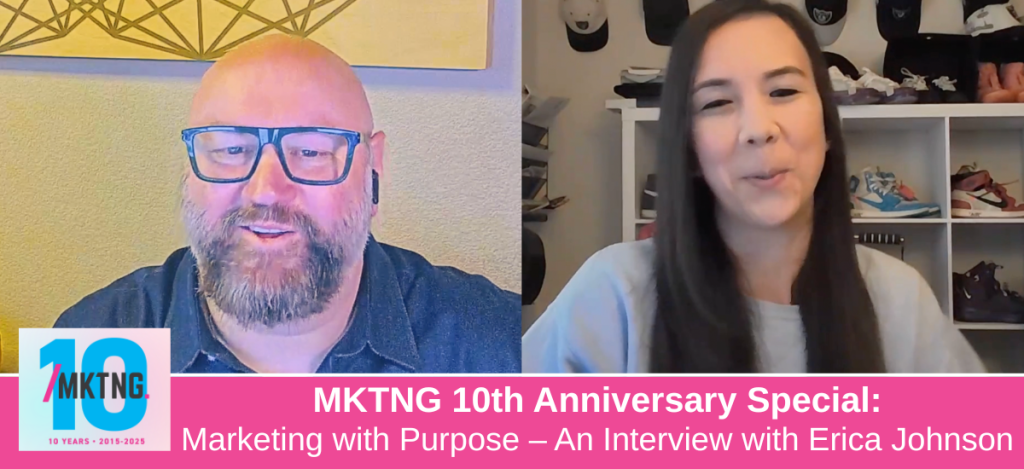
Join us for a dynamic conversation with Erica Johnson on the MKTNG 10 Year Podcast! A true force in marketing and community impact, Erica’s journey is a testament to passion and perseverance. Currently, the Associate Director of Brand Marketing at the American Foundation for Suicide Prevention (AFSP), Erica, ensures the marketing engine runs smoothly, making a profound difference one campaign at a time. In this episode, we rewind to Erica’s foundational days at MKTNG (2015-2016), where she excelled as an Account Executive, managing social media, pitching press releases, and boosting brands like Pottery World and The Big Day of Giving. We delve into her impactful five-year tenure at the Leukemia & Lymphoma Society, where she personally raised over $3.5 million, and her significant contributions to the local PR scene with PRSA. Erica shares insights into her current, newly created role at AFSP, highlighting the unique opportunity to shape the organization’s brand marketing efforts. We explore AFSP’s groundbreaking partnership with the band Papa Roach, which has not only raised funds but also significant awareness for suicide prevention through music and concerts. The conversation touches on the evolving landscape of social media, the rise of influencers, and the burgeoning role of AI, while emphasizing AFSP’s vital work in promoting mental health awareness and safe communication practices, especially among young people with campaigns like “Seize the Awkward.” Key Topics: MKTNG’s 10th Anniversary Erica’s MKTNG Beginnings as an Account Executive Erikc’s transition to brand marketing at AFSP. AFSP’s Critical Mission: suicide prevention and mental health awareness. The impactful Papa Roach partnership for AFSP. Supporting Youth Mental Health: The “Seize the Awkward” campaign. The Evolving Marketing Scene: Insights on social media trends, influencers, and AI’s emergence. MKTNG Memories: Recalling the “Art Hotel” project and the value of in-person collaboration. Erica’s expertise in social media and digital communication. Erica’s commitment to learning and development through the AMA. Transcription: Scott: All right Today we are thrilled to welcome Erica Johnson a dynamic force in marketing and community impact to the MKTNG 10 Year Podcast Erica’s journey is all about passion and perseverance and she’s currently shining as the Associate Director of Brand Marketing at the American Foundation for Suicide Prevention There she keeps the marketing engine humming ensuring seamless collaboration across writing PR social media and production making a real difference one campaign at a time Erica also spent over 5 years with the Leukemia & Lymphoma Society in Sacramento where she raised over $3.5 1000000 But let’s rewind a little bit Erica’s no stranger to MKTNG where she rocked it as an account executive for us back in 2015-2016 managing client social media pitching press releases and boosting brands like Pottery World and The Big Day of Giving Erica was also a part of our art hotel project with DBA Arts and M5 Arts From her early days at Sacramento State to her impactful tenure at the Leukemia & Lymphoma Society and her contributions to the local PR scene PRSA Erica built a career on determination leadership and a knack for connecting people Get ready for an inspiring chat with this er- er- organized upbeat leader who’s all about positive vibes and big results All right Erica welcome All right Erica: That was such a kind introduction I really appreciated that Scott: Well it’s all legit I looked it u- I looked it all up Erica: I do have good history I’ve kept for sure on a lot of my various platforms So I was like- Yeah Wow I have some of this in my notes too Scott: You’ve- You’ve got good PR Erica: Yes Scott: As you should ’cause you’ve been busy I’m so glad to catch up with you and talk more about what you’ve been into ’cause I’ve only just you know We’ve bumped into each other couple times in the last 10 years But- Yep Uh you’ve been up to so much so I’m looking forward to hearing what’s new Tell me a little bit just share right now what’s- what’s going on uh with your current gig Erica: Yeah So I am brand new to a brand new role So it’s really fun to step into a position where no one else has really molded it before So becoming the first associate director of brand marketing is a really cool and special and humbling opportunity for- for me to not only continue to make an impact in the realm of suicide prevention and mental health but also to support my colleagues and my fellow chapter staff members as someone who came from the fundraising volunteer development side as an area director So it’s really helpful to have a lot of that context and information like on the ground um with the community and being able to bring that to our c- national communications and marketing team Um so it’s been a really fun last I think it’s been now like 5 or so months um but it’s been over three and a half years or so at AFSP So it’s gone by fast It feels like it could be longer But it’s definitely been a really great place to grow and such inspirational and passionate people both the people I work with as well as the folks that we get to work with as volunteers and board members Um so it’s just a really uh special opportunity and moment I feel like in my career So I’m really excited about it Scott: Yeah And I’ve seen you guys have had like s- a well a cool partnership that I saw uh just late last year uh with Concerts in the Park even right That you guys- Oh yeah had a thing with Papa Roach and uh- Yes and a song like Was that song that he wrote uh I- I saw like he was donating proceeds was that with your- your organization Erica: right It was I was not able to be at that Concerts in the Park I was
MKTNG 10th Anniversary Special: An Interview with Our First Employee, Angela Ficarelli!
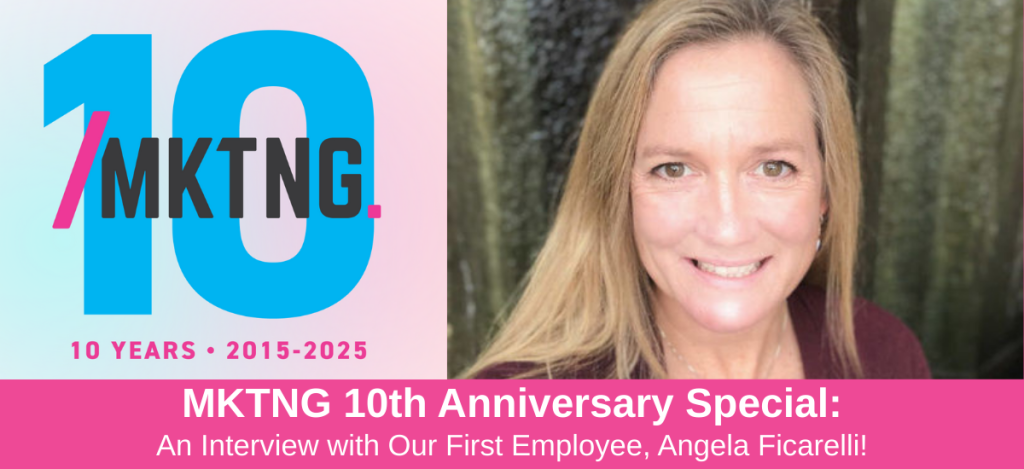
Join us as we celebrate MKTNG’s 10th anniversary with a special interview featuring our very first employee, Angela Ficarelli! In this episode, we take a trip down memory lane, discussing the early days of MKTNG and Angela’s pivotal role in building our client relationships and innovative strategies. Angela, now the marketing and business development director at Hilltop Radiology, shares her experiences and insights from her time at MKTNG, including memorable projects like the Stache Bash event at Palladio. We also dive into her current work, which focuses on personal connections and storytelling, and discuss her thoughts on the future of marketing in the age of AI. We explore how Angela continues to use the lean philosophy and social media calendar from her MKTNG days and her excitement for integrating new technologies like RingCentral and AI bots. Plus, she shares her favorite AI tools, including Grok, and her latest discovery of comfortable and stylish Earth shoes! Don’t miss this insightful and engaging conversation as we celebrate a decade of MKTNG with one of our founding members. Key Topics: MKTNG’s 10th Anniversary Early days of MKTNG with first employee Angela Ficarelli Memorable projects like Palladio’s Stash Bash Angela’s current role at Hilltop Radiology Marketing strategies: Personal connections vs. technology Using lean philosophy and social media calendars Future of marketing and healthcare with AI Favorite AI tools: Grok, ChatGPT, Gemini Product recommendations: Earth shoes Experiences with early social media and its evolution Transcription Speaker 1 [00.00.21]: Today, we are thrilled to welcome a very special guest to Mk G10 Angela Ficarelli. The one and only our very first employee here at Mk TNG. Angela joined us a decade ago back when we were just getting started. Angela came to us having been a co-founder of another digital marketing shop. She served MK as a director of Client services, where she built client relationships and drove results with innovative strategies. Angela has always had a knack for staying ahead of the curve. Over the years, she’s worked with an incredible range of brands, from luxury tile galleries to mortgage firms, and now, as marketing and business development director at Hilltop Radiology, she’s crafting authentic, story driven experiences that connect people to brands in meaningful ways. Angela’s passion for marketing. Her creative warrior spirit, and her ability to navigate this ever evolving landscape make her the perfect person to feature in our trip down memory lane. So let’s dive in. Angela, welcome back to the MKE TNG family, even if it’s just for the next 45 minutes. Speaker 2 [00.01.34]: Well, thank you so much. What a wonderful introduction. I appreciate that. Woo Speaker 1 [00.01.38]: hoo! Well I, you know, I, I we could spend 45 minutes. I just glow about you because I really enjoyed working with you. It was fantastic. Speaker 2 [00.01.48]: It was definitely a good time. It was definitely a good time. We were going through a lot of the same things at the same time as well, so it was definitely Speaker 1 [00.01.56]: a rush. Yes. Right. Yes. We get into all the history, but that was, uh. Yeah. Uh, you ended up living near each other and the kids were the same age, and, uh, we saw all the things, um, so pretty nuts. But, uh, let’s talk about what you’re up to now. What? Tell me about your current gig and and what you’re doing. Speaker 2 [00.02.22]: So I’ve pretty much been with Hilltop Imaging, where, um, we have three facilities, uh, in the Sacramento area. Well, one in Elk Grove and one in Roseville, and then one is in the Bay area. It’s under the umbrella Hilltop imaging. Um. And I’m the marketing director. I really do a lot of, uh, in person. Uh, in person, like 1 to 1 connections as well as, like, spoiling, spoiling people from, uh, with, you know, coffee dates and, and food and, and really sort of, um, trying to get that, that connection with them so that we can talk personally. Um, and, you know, it’s a little bit more of an emotional connection, uh, with our facility. Um, so, I mean, that really that’s kind of in a nutshell, what I do right now, which is completely different from what I’ve done in the past in terms of marketing. I started in traditional and then moved into digital. And so, uh, this is like a breath of fresh air because I feel like this is a part of me that’s, uh, that that’s really the part of me that comes out that is really, really Speaker 1 [00.03.35]: good. Right? Well, what I like. I like that your your job is very people centric, it sounds like. Right. Yes. And it’s funny when we talk about marketing, there’s just. Just for one. Very few people even understand what marketing, you know, means. Um, but you have people who do marketing, and it’s. I’m. I’m writing a response to an RFP for the government. Right. And they’re and they’re marketing people, but they sit at a computer all day and type thing, right? Uh, they’re really weird people. Um, and then, uh, and then there’s, you know, what we do here at McTeague, which is words and pictures and, you know, telling stories. Um, and it really is about, like, taking a brand and putting it in front of the masses. Um, and then there’s what you’re doing, which is like doing, you know, one on one, like going and relating to people and telling, telling them the story in person. Like kind of embodying the brand. Mhm. And going in. Yeah. Educating and storytelling. Speaker 2 [00.04.45]: So I, I do, I do provide. Um just so you know, I do provide um graphics. Like I’ll, I’ll come up with different graphic pieces which can be my like conversation starters with, um, when I’m in front of those people. It provides just
Ten Years of Spark: The MKTNG Origin Story
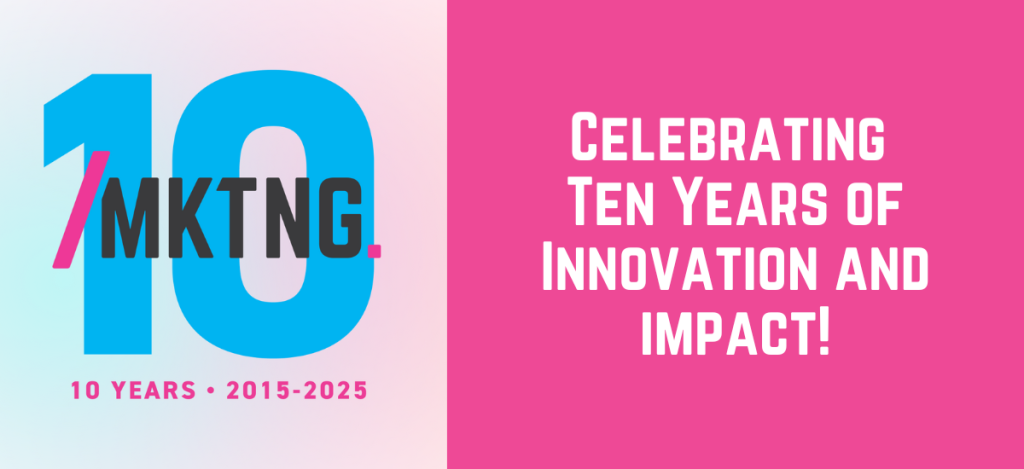
This year, MKTNG celebrates a decade of crafting compelling marketing strategies and delivering impactful results for our clients. It’s a milestone that fills us with pride and gratitude. But every journey has a beginning, and ours started with a spark – a moment of realization, a leap of faith, and a relentless drive to do things differently. To commemorate this special occasion, we sat down with our founder, Scott Eggert, to delve into how MKTNG was born. Here’s what he shared: From Freelance to Full-Fledged Agency: Scott’s journey began with a desire for balance. After years of demanding agency life, he sought a way to spend more time with his young family. A consulting opportunity with Kilroy Communications on the East Coast presented itself, focusing on digital strategy and social media. This led to exciting projects with the Florida Beef Council, Georgia Peaches, and other food and lifestyle brands, rekindling his passion for the food industry. “It was really cool to be back in food,” Scott recalls, “which was part of how I got my start in agency marketing.” Initially operating as “Scott Eggert Unincorporated,” a playful nod to his freelance status, Scott enjoyed the flexibility of consulting. However, the tide turned in late 2014. Clients began requesting more than just strategy; they needed execution. “All my clients at the same time said, ‘Thank you for giving us strategy, but we need more. We need you to do it for us,’” Scott explains. While he relished the strategic aspect, the idea of personally handling content calendars and photo sourcing didn’t resonate. Moreover, Scott envisioned a team-centric approach, not a solo venture. “I’ve never wanted to put my name on the door,” he says. “Teaming is about the team.” The Birth of MKTNG: Recognizing the need to evolve, Scott officially incorporated MKTNG in February 2015. He quickly hired Angela Antle (now Ficarrelli), MKTNG’s first employee, and began building a team capable of delivering comprehensive marketing services. Early clients like Kilroy Communications, Cresleigh Homes, and Palladio played a crucial role in MKTNG’s growth. The Philosophy Behind the Services: Scott’s experience in integrated agencies instilled in him the importance of offering a wide range of services, from public relations and creative to website development, social media, and content marketing. He wanted to provide clients a holistic approach, ensuring all their marketing needs were met under one roof. “I wanted to have all the tools in my toolbox,” he explains. Furthermore, MKTNG aimed to empower clients with choices. This philosophy was encapsulated in their initial motto, “Just What You Need,” a double entendre suggesting both comprehensive and tailored solutions. Looking Ahead: As we celebrate our 10th anniversary, we reflect on the journey that brought us here. From a solo consulting venture to a thriving marketing agency, MKTNG’s story is one of passion, dedication, and a commitment to delivering exceptional results. We’re incredibly grateful to our clients, partners, and team members for being part of this incredible journey. Here’s to many more years of innovation, growth, and success!
6 Top Paid Media Trends to Watch in 2024

In today’s digital playground, change isn’t just happening—it’s hitting the gas! Gartner’s 2023 CMO Spend and Strategy Survey reveals that 25.6% of marketing budgets are now devoted to paid media, highlighting its star role in brands’ modern marketing strategies. With new tech, shifting consumer habits, and fresh regulations, it’s time not just to keep up but to lead the charge in new ways to reach your target customers. As we dive into media trends for 2024, innovation is shaking up advertising strategies like never before. Keeping up with emerging trends and aligning them with marketing objectives is crucial for brands and agencies to stay ahead and succeed. Whether you aim to boost brand awareness, increase website traffic, enhance customer loyalty, or improve conversion rates, aligning these trends with your business goals is key to an effective strategy. From location targeting to the rise of AI and machine learning, each trend offers unique opportunities and challenges for marketers eager to stay ahead of the curve. Let’s explore these trends and their implications for advertisers in the ever-evolving digital ecosystem. Trend 1: Location-Based Targeting Location targeting is taking the advertising world by storm, allowing marketers to deliver highly relevant content based on where their audience is. Here’s how it works: Geofencing: Draw a virtual fence around a specific location and serve ads to mobile users within that area. Geoframing: Collect mobile device IDs from users who have been in a predefined location at a specific time, allowing you to target them even after they leave. Geolocation Targeting: Pinpoint your ads to countries, cities, neighborhoods, or even postal codes. These tactics help increase brand visibility, compete with bigger brands, and capture your audience’s attention at the right place and time. The ad platforms MKTNG utilizes excel at location targeting and deliver impactful results. Trend 2: Ad Optimization With AI and Machine Learning AI and machine learning are revolutionizing the paid media landscape. These technologies bring unparalleled precision and efficiency to ad targeting, bidding, and personalization. They use algorithms to predict audience behavior and optimize campaigns in real time, significantly boosting ROI and campaign effectiveness. AI streamlines processes, enhances scalability, and provides deeper insights into performance, making data-driven decision-making easier than ever. Trend 3: Better Branding With Interactive and Immersive Ad Formats Interactive and immersive ad formats, such as augmented reality (AR), virtual reality (VR), and interactive video, are changing the branding game. These formats offer deeper, more engaging experiences that capture consumers’ attention like never before. Brands are using these technologies to create compelling interactions that resonate with their audiences. Trend 4: Driving Sales With Social Commerce and Shoppable Ads Social media platforms are evolving into shopping destinations, integrating e-commerce directly into ads. Shoppable ads turn engagement into revenue, transforming social platforms into valuable sales channels. Brands are leveraging these trends to drive sales and build stronger customer relationships. Trend 5: Increasing Reliance on Third-Party Cookie Alternatives With Google phasing out third-party cookies by early 2025, marketers face uncertainty about future tracking, targeting, and measurement. However, this shift also opens doors for innovative strategies. We see this as a significant opportunity for industry collaboration and innovation to utilize different ways to collect and use first-party data to market brands more strategically. Trend 6: Increased Ad Competition Due to Market Consolidation The media industry is experiencing significant consolidation, with major mergers like Disney’s acquisition of Twentieth Century Fox reshaping the landscape. This trend centralizes control, creating larger media conglomerates with enhanced bargaining power and strategic capabilities. However, it also means fewer independent media outlets and more competition for ad spaces, leading to higher prices and less negotiability. Advertisers must build strong relationships with these conglomerates and leverage their integrated advertising solutions to reach wider audiences effectively. As we’ve explored the changing world of paid media in 2024, it’s clear that your brand’s success hinges on spotting key trends and using them effectively. Matching these emerging trends with specific business goals allows brands and agencies to uncover fresh avenues for growth and interaction. Whether using location targeting for precise audience reach or adopting AI and machine learning to boost ad performance, strategically integrating these trends is crucial for driving outcomes. Navigating the dynamic realm of paid media requires staying innovative and adaptable. Embracing change and trying out new strategies enable marketers to keep up with the evolving digital landscape and even shape the future of advertising. If you’d like to explore how to utilize paid media best to reach your target audience and grow your brand’s reach, the MKTNG team is here to help. Call 855-MKTNGCO or contact us today to get started!
Accelerating Growth: Leveraging the Strategic Power of Paid Media

Paid media isn’t just another item to tick off your marketing checklist; it’s a powerful strategy that drives growth and boosts your brand’s influence. Here’s why paid media is crucial for any well-rounded marketing plan: Elevating Your Brand Beyond Organic Reach Paid media helps amplify your brand’s message beyond what organic efforts can achieve alone. Think of it as boosting your brand’s volume, ensuring it reaches a wider audience. When your organic reach reaches its peak, paid media ensures that your content and messages are seen by the right people at the right moment. According to data from Techjury, PPC traffic has a 50% higher conversion rate compared to organic site visitors. Amplifying Brand Reach with Targeted Paid Media Picture having a super precise tool for your marketing campaigns. Well, that’s what paid media gives you. You can target specific demographics, behaviors, and interests with super-detailed options. Forget about wasting resources on people who aren’t interested. With our awesome strategy team supporting you, your message hits just the right audience your brand wants to connect with. Paid Media Drives Brand Growth Paid media isn’t just about increasing impressions; it’s about driving action and conversions. It drives traffic to your landing pages, products, or lead forms. When a user clicks, subscribes, or makes a purchase, that’s where the magic happens. Paid media is a direct catalyst for conversions and revenue, turning interest into tangible results. If you’d like to explore how to utilize paid media best to reach your target audience and grow your brand’s reach, the MKTNG team is here to help. Call 855-MKTNGCO or contact us today to get started!
Evolution of Paid Media
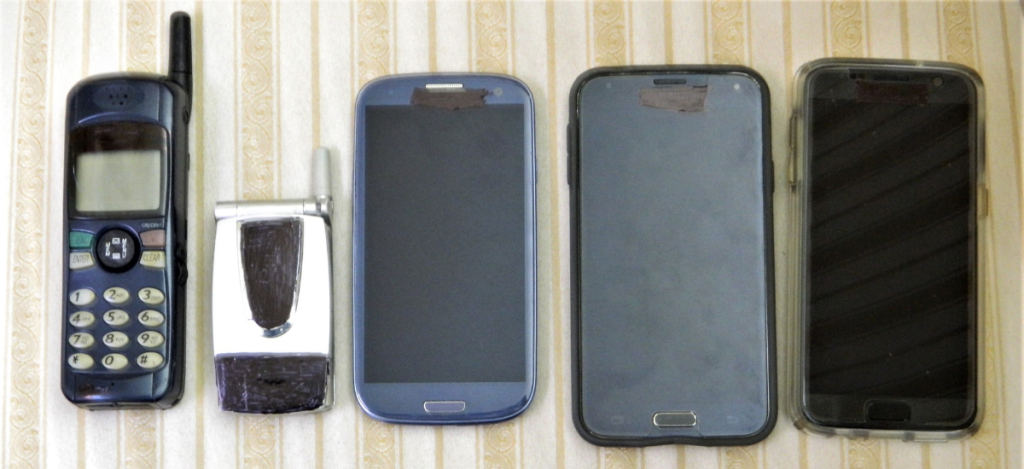
In the ever-evolving realm of digital marketing, paid media has undergone a series of transformative changes, reshaping how brands connect with their audiences. From the dawn of the internet to the current era of advanced analytics, the strategies and technologies driving paid media have continually adapted to meet the needs of both advertisers and consumers. Understanding this evolution is crucial for anyone looking to harness the power of paid media effectively. Let’s take a closer look at the key milestones in the journey of paid media over the years. Early 2000s: Keyword-Centric Approach Remember the days of intense keyword bidding wars? Advertisers fiercely competed for top spots in search engine results, trying to outbid each other for visibility. 2010s: Segmentation and Personalization Enter the era of targeted ad placements. Thanks to more sophisticated platforms, advertisers could now tailor their campaigns based on demographics, behavior, and interests. It was all about getting the right message to the right person. 2010s-2020s: Mobile and Video Dominance As smartphones took over, so did mobile-optimized content and video ads. Platforms like YouTube became key for engaging audiences with video. Meanwhile, streaming giants like Netflix and Disney+ rose to prominence, offering a vast library of TV shows and movies. Connected TV (CTV) emerged as the technical core for programmatic TV (PTV), enabling precise audience-based targeting. Present: Data-Driven Optimization Today, it’s all about using advanced analytics and machine learning to fine-tune campaigns in real time. Every click, impression, and interaction informs adjustments. CTV ads are now streamed through smart TVs, connected devices (Roku, Amazon Fire Stick, etc.), and gaming consoles. Advertisers are leveraging CTV’s flexibility to communicate with customers throughout their buying journey. With CTV ad spending projected to reach over $41 billion by 2027, it’s clear this trend is here to stay. If you’d like to explore how to utilize paid media best to reach your target audience and grow your brand’s reach, the MKTNG team is here to help. Call 855-MKTNGCO or contact us today to get started!
Navigating Digital Paid Media
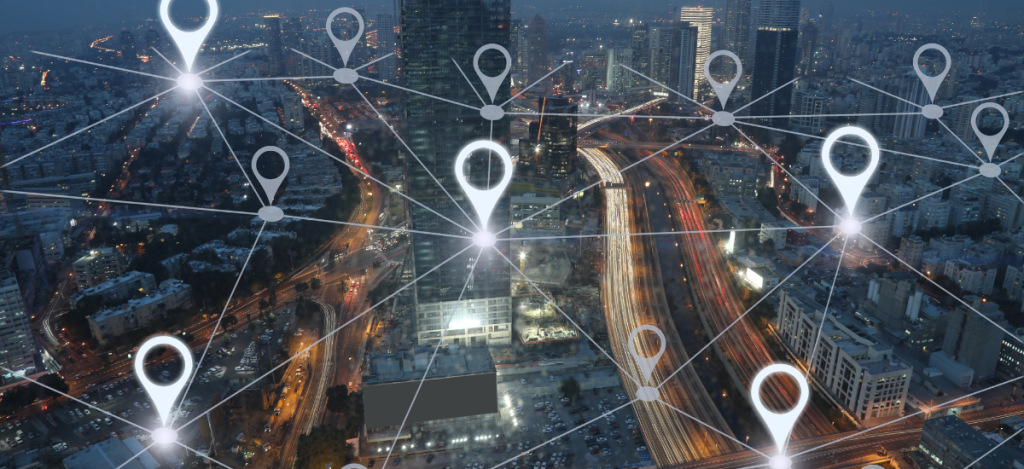
Paid media revolves around strategic promotion with specific goals or key performance indicators (KPI) in mind. Those specific goals utilize particular marketing mediums as ways to achieve them efficiently. Brands invest in exposure and visibility across various digital platforms such as search engines, social media, display networks, Connected TV (CTV), and more. The primary objective? Targeting the appropriate audience, driving traffic, and converting leads. Now, let’s dissect paid media into five fundamental components: Display Advertising: You’ve seen those eye-catching banners or videos that pop up on websites, right? That’s display advertising in action. They’re designed to grab your attention and entice you to click for more information. Google runs the biggest display ads network, reaching a significant portion of internet users worldwide. This vast network spans over 35 million websites, apps, and properties owned by Google. Native Advertising: Have you ever been reading an article online or watching a show on your favorite streaming platform, and you suddenly see a recommendation for a product or service that fits perfectly with what you’re already enjoying? That’s native advertising. It seamlessly blends into the content you’re engaging with, making it feel like a natural part of your experience. And guess what? It’s effective. According to the 2024 Gitnux Marketdata Report, native ads can boost brand awareness by as much as 82%. Content Promotion Advertising: At times, brands aim to reach a wider audience with their content. That’s where content promotion steps in. Whether it’s a blog post, a video, or an infographic, companies can invest in promoting it to ensure more people see and interact with it. This practice is on the rise. According to Zippia, in 2024, 45% of content marketers anticipate an increase in their content marketing budget. Search Engine Advertising (SEA): Have you ever spotted those ads right at the top of your search results? That’s what we call paid search at work. When you look for something online, like “best pizza near me,” those businesses have paid to show up there. Platforms like Google Ads let companies bid on specific keywords to make their ads more visible. And guess what? It’s a big deal. According to eMarketer, a whopping 42% of all digital marketing spending is dedicated to search marketing. Why? Because it works really well. Social Media Advertising: You’ve likely come across sponsored posts on your Facebook or Instagram feed, right? That’s social media advertising in action. Advertisers can tailor their campaigns based on factors like your age, interests, and even your online conversations. And here’s an interesting fact: according to a recent report from Datareportal, more folks discover new brands, products, and services through social media ads than through word-of-mouth recommendations, brand websites, or consumer review sites. If you’d like to explore how to utilize paid media best to reach your target audience and grow your brand’s reach, the MKTNG team is here to help. Call 855-MKTNGCO or contact us today to get started!
Google Display Network vs. Programmatic – What’s Best for Your Brand?

Marketers are set to spend more than $460 billion on digital advertising in 2024, and with automated advertising now making up over 80% of the total digital display ad spend in the U.S., the landscape is buzzing with opportunity! But choosing between programmatic advertising and Google Ads can feel like navigating a maze. Fear not—we’re here to demystify these two powerhouses and help you determine which suits your business best. A Fresh Approach to Online Advertising Gone are the days when advertisers had to negotiate directly with website owners and bloggers to place their ads transactionally. That old-school method was time-consuming and often inefficient. Enter programmatic advertising and the Google Display Network (GDN)—these tools automate the process, making it a breeze. Set your parameters, and the system does the rest! Unleashing the Potential of Google Display Network The Google Display Network is like having a backstage pass to the internet. Partnering with millions of websites, YouTube, emails, blogs, and mobile apps, GDN allows your ads to reach up to 90% of internet users worldwide. Imagine the reach! GDN uses your specified criteria—like age, gender, and interests—to display your ads to the right audience at the right time. Decoding Programmatic Advertising Like Google Display Network, programmatic ads are automated but with a broader reach. They cover multiple ad networks, including Google Display Network and native ads. Advertisers use Demand-Side Platforms (DSPs) to buy ad space, while publishers use Supply-Side Platforms (SSPs) to sell it. This seamless connection between advertisers and publishers, facilitated by real-time bidding (RTB), ensures your ads reach the right audience at the right time for the right price, ensuring ROI for your marketing investment. Behavioral Advertising and Its Evolution Programmatic ads initially relied heavily on behavioral data—showing ads based on online activity. However, with privacy regulations like GDPR, this method is evolving. Now, ads are increasingly based on the content of the websites you visit, offering a more privacy-conscious approach. Inside the World of Programmatic Ads Programmatic campaigns are more expansive than GDN campaigns, incorporating various platforms through DSPs and SSPs. Real-time bidding allows advertisers to bid for ad space dynamically. Here’s a rundown of the types of deals you might encounter: Open Auction: The most common RTB model. Private Auction: Limited to selected advertisers. Preferred Deal: Fixed-price ad space for premium spots. Programmatic Guaranteed: Direct deals between advertisers and publishers. Comparing Google Display Network and Programmatic Advertising While both GDN and programmatic advertising automate the ad placement process and offer extensive targeting options, there are key differences: Pricing: GDN offers CPC, CPM, and CPA models, which can be more budget-friendly. Programmatic advertising primarily uses the CPM model, potentially increasing costs. Cost-Effectiveness: Both methods are efficient, but programmatic’s real-time bidding can reach a wider audience, albeit at a higher price. Video Advertising: Programmatic advertising excels in video ad placement, providing more options outside YouTube. Choosing Between Programmatic Advertising and Google Display Network Both programmatic advertising and GDN have their unique strengths. Google Display Network can be good for advertisers looking to stay within Google’s Network. At the same time, programmatic advertising offers broader reach and sophisticated targeting for those ready to ensure their campaign effectiveness. MKTNG is here to help you choose the best way to leverage these tools to enhance your digital marketing strategy and grow your brand significantly. Give us a call at 855-MKTNGCO or contact us here today to get started!
